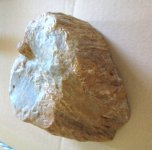Ironwill
Jr. Member
- Jul 2, 2013
- 91
- 31
- Primary Interest:
- All Treasure Hunting
Probably the closest we have is the Jason Baxter account, in which Baxter calls the placer deposit the "Snively Diggings". This is based on an encounter Baxter describes in which he and two others met Snively in Pinos Altos in 1863. Snively was reportedly carrying $10,000 in placer gold (30 pounds!) from a rich deposit that he had just left because of Apache trouble. Baxter was a well-respected frontiersman of the day whose integrity was apparently unchallenged. It's all in Black Range Tales, written by another solid participant of the times, James McKenna.
What if the timing of the encounter is wrong. What if Snively was the German, and it was 1865 not 63. Perhaps Pinos Altos is where Snively came to town with his near 60 pounds of gold from Adams diggings when he left their party before the Apache slaughter. 60 pounds of gold would be about 14-15 dollars an ounce and around 10,500 or so back then. When selling gold to an assayer, usually you give up 20% for the assayer's cost of smelting and filtering out impurities. It was 18.90 / ounce back then and 20% cut would be around 15.00/ ounce. I think that would put poundage near 55 pounds...which is almost identical to what the German left Adams party with before they were slaughtered. If only we had a newspaper clipping of when that Snively actually came into Pinos Altos, that could clear up the date issue.







